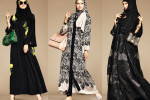This article was written for Muslimah Media Watch by Anny Gaul.
Yesterday, The New York Times ran an article about what Iraqi women are wearing these days. It paints a picture of a once-secular society’s pluralism run amok: “Vendors around the Kadhimiya mosque in northern Baghdad sell all manner of women’s clothing, from drape-like black abayas to racy evening wear. But on a recent afternoon, Hameed Ibrahim ushered his family toward a different kind of fashion display.” The piece goes on to describe an exhibit displayed by a local mosque that features female mannequins in Western-style outfits, surrounded by leering images of men and the flames of hell. An enthusiastic local father is interviewed about the virtues of this display and the message it sends.
John Leland, the author, aims for some of the greatest advantages journalism can offer – a dialogue with people on the ground and a candid account of the immediate events that shape their lives – and yet falls into the trap of oversimplifying complex social phenomena and reinforcing stereotypes about Arabs and Muslims (especially Arab and Muslim women). It exhibits the double standards international journalism so often applies to Arab cultures, and most of all, it demonstrates how, time and time again, women’s bodies are made to bear the burden of progress, development, and even the level of pluralism or democracy within their societies.
The article’s language contributes to its rhetoric considerably: names like Um Noor and Abu Karar are glossed in parentheses (“mother of Noor,” “father of Karar”) as if to imply that the strictures of Arab family ties are so paramount that they embody one’s entire identity (I doubt the Times has ever explicated a Russian patronymic this way). It describes an “abaya battle” within Iraqi society, likening it to American “culture wars” – never mind that the mosque in question is giving away headscarves, not abayas, according to the article. When all forms of Islamic dress are rhetorically elided into one garment, it not only distorts reality – it also blurs the important notion that most Muslim women in the world exercise some sense of choice in the way they dress (just like non-Muslim women do).
The overall structure of the article is similarly problematic. Focusing as it does primarily on one mosque in one section of Baghdad, and a few individuals’ take on it, the article leaves the reader with little context of how women’s dress actually does fit into Iraqi society as a whole. One could easily paint a similar picture of the “ascendancy of religious values” in American society by focusing on radical religious leaders or splinter conservative groups. The problem is that we have no idea how exceptional (or common) the attitudes that the article leads with and focuses on actually are.
Arguably, the most insightful part of the piece is buried near the bottom – a quotation from Dr. Nada Abed al-Majeed al-Ansari, who describes the highlighted trends as a reaction, in part, to decades of suppression of religious beliefs as well as years of war and sanctions. Most notably, she asserts that there is “no movement for an official imposition of Islamic law,” thus situating the subject in historical, social, and political contexts.
If we leave aside the fact that the article sets up polarized, stock characters to speak for Iraqi women (notably, one who has adopted “doctor” as her title and the other who has adopted “mother” as hers), each woman, in her own way, demonstrates that perhaps what is really shaping Iraqi women’s dress is a range of social, personal, and cultural factors working to persuade, rather than coerce. Whether Iraqi society is more or less religious or secular is beside the point; in a democratic society, the point is notions of choice and how those choices are conditioned and constructed.
It’s counterproductive for the West to support the invasion and “liberation” of a country and the attempted conversion of its political system to a version of democracy, and then point fingers when the choices made within the new spaces these changes create gravitate towards things it finds distasteful (like abayas or religious rhetoric). The average American woman is not confronted with displays of abayas every day, but she is confronted with endless advertisements that promote their own forms of persuasion about how she should adorn or dress or condition her body. If we in the West are willing to concede that our fashion and beauty products can potentially be sources of empowerment or negative influences or both of those things, why can we not extend a similar latitude in judgment to a headscarf or an abaya?
Certainly the issue is complicated; the article’s documenting of increasingly harassing remarks directed towards women in less conservative dress is deeply troubling, but again, one is left to wonder about the many factors that may contribute to it along with a change in religious values: changing social patterns, exposure to new forms of media (which the article mentions in passing), economic stress and chronic unemployment – not to mention the physical and psychological havoc of a foreign invasion and occupation.
The point of identifying and highlighting negative phenomena in any society should be to do so with enough clarity to enable positive change to occur. Good journalism must go beyond glib claims that “women’s clothing has served as a barometer not just of fashion, but of the current ascendancy of religious values in a once secular society.” Representations like this can serve to veil women’s agency just as much as an article of clothing can.

